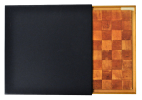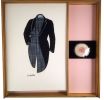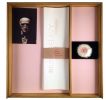Marcel Duchamp
DUCHAMP
Anvers Ronny Van de Velde 1991 1 372x372x60mm DUCHAMP. (Catalogue). Marcel Duchamp. Anvers, Ronny Van de Velde 1991. Boîte en bois 372 x 372 x 60 mm reproduisant l'échiquier de 1937 et renfermant: Le catalogue des oeuvres exposées ( 64pp, 340 x 107 mm); un porfolio 340 x 240 mm contenant de nombreuses reproductions; un colophon; un recueil 340 x 240 mm d'articles d'André Breton et Arturo Schwarz sur Marcel Duchamp; une audio cassette présentant une interview et une lecture de texte, la couverture reproduisant en format réduit le Sein qui ornait l'édition de tête du catalogue de l'exposition surréaliste de 1947. Édition limitée à 850 exemplaires. (100097)
Reference : 100097
372x372x60mm Boîte Très bon
Bookseller's contact details
Librairie Chloé et Denis Ozanne Déesse sarl
M. Denis Ozanne
21 rue Monge
75005 Paris
France
+33 1 48 01 02 37
Payment mode



Sale conditions
Conforme aux usages de la librairie ancienne et moderne, tous les ouvrages présentés sont complets et en bon état, sauf indication contraire. L'exécution des commandes téléphonées est garantie mais sans règle absolue, la disponibilité des livres n'étant pas toujours vérifiable lors de l'appel. Les frais de port sont à la charge du destinataire. Les livres sont payables à la commande. Nous acceptons les règlements par chèque bancaire ou postal, mandat postal ou international, carte bancaire, Visa, Eurocard, MasterCard et virements bancaires dans certaines conditions.
5 book(s) with the same title
Etant donné Marcel Duchamp N°1
Baby Association pour l'étude de Marcel Duchamp - AEMD 1998 In-4 broché, couverture illutrée
Premier numéro de cette revue consacrée à Duchamp. Sommaire: Dominique Chateau et Michel Vanpeene : Entretien avec Jean Suquet -- Jean Suquet : Le Hasard Objectif -- Michel Sanouillet : Marcel Duchamp et la tradition intellectuelle française -- François le Penven: Du verbal au verbe : Duchamp à l'infinitif -- Molly Nesbit et Naomi Sawelson-Gorse : Concept de rien Nouvelles notes de Marcel Duchamp et Walter Arensberg -- Michèle Humbert : Duchamp et les avatars du silence -- Naomi Sawelson-Gorse : Sur le gril Entretien inédit de Marcel Duchamp avec Mike Wallace -- André Gervais : Distinguo -- André Gervais : Note sur le terme readymade (ou ready-made) -- André Gervais : Liste des readymades de Marcel Duchamp (1913-1967) -- Michel Dupré : Les Rois de la petite reine -- Dominique Chateau et Michel Vanpeene : Catalogue raisonné des readymades 1 -- Georges Renaud : Un prix de beauté. Nombreuses illustrations et photographies en noir et en couleurs. 160 pp. Inséré dépliant cartonné annonçant la parution de la revue. Très bon 0
DUCHAMP'S ENDGAME D rer, da Vinci, Poussin and Ingres
, Mercatorfonds, 2024 HB, 250 x 190 mm, 192 p, 200 illustrations, ENG edition. ISBN 9789462303737.
In 1912 was Marcel Duchamp ontgoocheld in de Franse kunstscene. Daarom verliet hij Parijs en bracht hij drie maanden in M nchen door. Hij beschrijft deze periode als de plaats van zijn 'complete bevrijding' en ze zette de toon voor de rest van zijn leven. Het was in M nchen dat hij besloot om te stoppen met schilderen en in plaats daarvan readymades te maken. De hele loop van de 20ste-eeuwse kunstgeschiedenis veranderde als direct gevolg van deze 'complete bevrijding' en toch weten we niet wat er toen gebeurd is, behalve dat Duchamp twee kleine schilderijen en enkele tekeningen maakte. Honderd jaar later was de Zuid-Afrikaanse kunstenaar Kendell Geers in M nchen om een retrospectieve tentoonstelling op te stellen in het Haus der Kunst, en hij kwam in een depressie terecht door zijn eigen ontgoocheling in de kunstscene. 'Duchamp's Endgame' is een persoonlijk boek over een kunstenaar die naar het werk van een andere kunstenaar kijkt en probeert om een honderd jaar oud enigma te doorgronden, te doorgronden wat het betekent o"Duchamp's Endgame" answers the century old question, what did Marcel Duchamp do in Munich in 1912 and why did he stop painting ? The book follows a visual logic driven by the question of how artists construct their imagery. In 1912 Marcel Duchamp was disillusioned with the French art scene, so leaves Paris and spent 3 months in Munich. He describes this period as the scene of his "complete liberation" and it set the tone for the rest of his life. It was in Munich that he decided to stop painting and instead create readymade works of art. The entire course of twentieth century art history changes as a direct result of this "complete liberation" and yet we know absolutely nothing about what happened, except that Duchamp created 2 small paintings and a few drawings. One hundred years later, South African artist Kendell Geers was in Munich to install a retrospective at the Haus der Kunst, and fell into a depression on account of his own disillusionment with the art scene. "Duchamp's Endgame" is a personal book about one artist looking at the work of another artist, trying to make sense of a century old enigma, trying to make sense of what it means to be an artist. Geers offers a unique reading of Duchamp that takes the reader on a labyrinthine journey through art history, revealing how one generation of artists secretly looked at another generation artists, all the way back to Leonardo da Vinci via Cranach, Poussin, Ingres and Durer. "Duchamp's Endgame" is a passionate story about art and the real life art historical version of the "Da Vinci Code" written by a contemporary artist with his tongue firmly in our cheek. A century after Duchamp declared painting is dead, nobody has yet offered any evidence beyond conjecture what he meant by that statement. Kendell Geers uses the works of art themselves as visual evidence to explain what Duchamp was looking at and researching during his 3 month stay in Munich. The book follows the links between works of art created by 5 generations of artists, explored through the eyes of the artists themselves. "Duchamp's Endgame" is entirely divergent from the official art historical canon on Marcel Duchamp in arguing that he was the last of a long line of classical European painters and not the American iconoclast of his reputation. The book focuses on the way artists think about other artists and argues that art historians have paid more attention to quoting each other, rather than taking the time to look at the actual works of art. Kendell Geers has published in numerous art historical journals as well as contributed to books and conferences. In 2022 he presented a paper on African Art at a conference in Harvard University and in 2023 published an essay in Gavin Jantjes' retrospective catalogue for The Africa Institute and Sharjah Art Foundation. The book draws upon statements and quotes from Marcel Duchamp, but is entirely the author's own theory. The publication accompanies a solo exhibition at Wilde Gallery in Basel presented during the Basel Art Fair.
[Affiche] (Action) - UNE TRIPLETTE AUX PRISES AVEC UN SPECTRE.Selon ses dernières volontés / le corps de Marcel Duchamp / est inhumé au musée / de Philadelphie. Pennsylvanie. Usa. / Qu'Aillaud, Arroyo et Recalcati / viennent se présenter au mort.LE MORT / ... Et revendiquent toutes les conséquences de leur oeuvre. [et, en très petit corps : ] Paris, le 26 septembre 1965 / [signatures autographiées : ] Gilles Aillaud / Arroyo / Recalcati.
1 Sans lieu, impr. Média-Plan international ?, 1980, affiche sérigraphiée (60 x 80 cm) à fond vert et large encadrement jaune, portant en pied la mention "Affiche apposée à Paris le 14 2 80" ; à gauche de la triple signature, faux tampon rond à fond rose et impression blanche : profil de M.D. au cigare, dans une couronne de lauriers elle-même entourée du texte suivant : Duchamp 1976 Donneur / Intesat ou avec Test ? [en pied, en arrondi et sous un filet blanc, la sentence :] "La liberté est supérieure à la liberté". [Le mot] "Intestin" barre en biais le crâne de M.D.
Bernard Marcadé : Marcel Duchamp : « En septembre 65, dans le cadre de lexposition "La Figuration narrative" dans lespace contemporain à la Galerie Raymond Creuze, trois jeunes peintres, Arroyo, Aillaud et Recalcati exposent une série de tableaux ayant pour titre : Vivre et laisser mourir ou La fin tragique de Marcel Duchamp. La pièce se présente comme une suite narrative de huit tableaux, mêlant à la fois des reproductions des uvres de M.D. (le Nu, Fresh widow, Fontaine, le Grand Verre) à des scènes daction (Duchamp montant un escalier, le « passage à tabac » de lartiste par les trois peintres, la condamnation de lartiste, lassassinat de Duchamp, mis à nu, puis précipité du haut de lescalier, les funérailles de M.D.) « Lallégorie est simple et évidente, cette peinture se veut une violente critique du rôle de Duchamp, implicitement accusé de faire le jeu de limpérialisme américain (nous sommes en pleine guerre du Viet-Nam), en dépit de la posture pseudo-révolutionnaire de son art. Le cercueil de Duchamp, entouré du drapeau américain, est porté en terre par Rauschenberg, Oldenburg, Raysse, Warhol, Restany et Arman en tenues de « Marines » américains. Lexposition est assortie dun manifeste stigmatisant le caractère éminemment « réactionnaire » de lart de Duchamp. « Au mois doctobre 1965, avant de repartir aux Etats-Unis, Duchamp visite donc lexposition de la Galerie Creuze. « Je vous avoue que cétait amusant à regarder. Cétait bêta comme peinture, mais cela ne fait rien ; ill fallait que ce soit comme cela pour ce quils voulaient prouver ; cétait peint bêtement, mais cétait très net. Ils sétaient donné un mal de chien. (...) » Duchamp dissuade Arturo Schwarz, André Breton, José Pierre de réagir : « La seule réfutation cest lindifférence. » Je n'ai trouvé nulle trace de la présente affiche dont laspect peut laisser supposer un affichage en plein air. Énigmatique. Bernard Marcadé : Marcel Duchamp. Paris, Flammarion, "Grandes biographies", pp. 486-487.
MARCEL DUCHAMP.
, Koenig Verlag, 2022 hardcover+booklet + slipcase, 330 x 250 mm, 254 pages, ENG edition. ISBN 9783906915517.
Marcel Duchamp, the artist's first legendary monograph and draft catalogue raisonn , was written by art historian and novelist Robert Lebel and published in French in 1959; later that same year, it was translated into English by George Heard Hamilton for Grove Press. The book was a cooperation between Lebel and Duchamp, and beyond Lebel's extensive writing and bibliography, additional chapters were authored by Duchamp, H.P. Roch and Andr Breton. The coupling of these texts with diverse archival photographs and an illustrated compendium of Duchamp's artworks delivered a complex and personal rendering of the artist's life and inner circle. For the first time since its release more than 60 years ago, this landmark publication is back in circulation with Hauser & Wirth Publishers' meticulous facsimile of the English edition, reflecting everything from its hand-tipped images to its recto-verso dust jacket appearing as close to the original as possible. Fully authorized by artist Jean-Jacques Lebel--Robert Lebel's son--and the Association Marcel Duchamp, the facsimile is accompanied by a supplement volume of essays and archival material that tells the story of Duchamp and Lebel's close collaboration, and, as contributor Michael Taylor writes, how the original publication signified a sea change in the artist's receptivity to critical interpretation. The supplement includes texts by both Robert and Jean-Jacques Lebel and a newly discovered note by Man Ray, among a bevy of photographs from the Lebel and Duchamp archives, extending the story presented in the 1959 edition. Robert Lebel's analysis of Duchamp's oeuvre remains fresh to this day, as does the book's design, which was personally supervised by the artist. Hauser & Wirth Publishers reanimated Marcel Duchamp with the curatorial-design firm fluid, who recast the original typefaces as digital fonts, positioning each letter and image exactly as it was in the original. To achieve a near-exact facsimile, fluid consulted with paper conservators and printers to recreate the book with modern materials that match those available in 1959. This precise production quality assures that today's readers will experience this historic book as Marcel Duchamp and Robert Lebel intended.
Etant donné n°1 premier semestre 1999 - Marcel Duchamp - Entretien avec Jacques Suquet - le hasard objectif - Marcel Duchamp et la tradition intellectuelle française - du verbal au verbe : Duchamp à l'infinitf - concept de rien nouvelles notes ...
Association pour l'Etude de Marcel Duchamp / Revue Etant donné. 1999. In-4. Broché. Bon état, Couv. convenable, Dos satisfaisant, Intérieur frais. 154 pages - couverture contrepliée - nombreuses illustrations en noir et blanc dans et hors texte - texte sur deux colonnes.. . . . Classification Dewey : 70.49-Presse illustrée, magazines, revues
Sommaire : Entretien avec Jacques Suquet - le hasard objectif - Marcel Duchamp et la tradition intellectuelle française - du verbal au verbe : Duchamp à l'infinitf - concept de rien nouvelles notes de Marcel Duchamp et Walter Arensberg - Duchamp et les avatars du silence - sur le gril entretien inédit de Marcel Duchamp avec Mike Wallace - distinguo - note sur le terme readymade (ou ready-made) - liste des readymades de Marcel Duchamp 1913-1967 - les rois de la petite reine - catalogue raisonné des ready-mades 1 - un prix de beauté. Classification Dewey : 70.49-Presse illustrée, magazines, revues
 Write to the booksellers
Write to the booksellers





